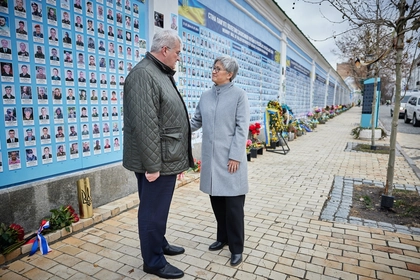US President Joe Biden's decision on Wednesday to approve the provision of anti-personnel landmines (APL) to Ukraine may not have the impact allies are hoping for, according to one Kyiv-based munitions expert.
While any additional allowance will help increase Ukraine’s arsenal of weapons it can use against Russia, a lack of details about the timeline of the provision and what will be included gives little confidence that the move will have a significant impact on the front, the expert said. And a lot depends on the type and quantity of the mines that are given.
JOIN US ON TELEGRAM
Follow our coverage of the war on the @Kyivpost_official.

“The Biden administration’s announcement that the US will provide anti-personnel landmines to Ukraine cannot be treated seriously yet,” the expert, who requested anonymity to comment on sensitive political matters, told Kyiv Post.
“Since the full-scale invasion, most physical assistance to Ukraine from the US has been delayed by bureaucracy or faced technical challenges due to the age of the ammunition.”

Canada’s Chrystia Freeland – A Personal View
Older arms are more prone to malfunction and often take more time to use and maintain.
“In particular, ammunition manufactured in the 1960s and 1970s must be ‘proofed’ before it is shipped through testing and inspections – this often reveals that refurbishment or modification is required,” the expert said.
The UAF should be prepared to wait before receiving a variety of mines left over from the American military’s involvement in conflicts across the world.
“Most of the USA’s landmine stock, both antitank and antipersonnel, are aging ammunition retained in anticipation of renewed conflict on the Korean peninsula,” he explained. “If the ‘antipersonnel landmines’ are in fact more modern variants or cluster munitions, then additional complications are likely.”
But so far, it's all just a guess.
“Until the exact models of the landmines and associated deployment equipment are known it is not practical to speculate on the effects they will have on the war, regardless of proposed delivery timelines.”
Biden’s decision to furnish the anti-personnel mines comes just days after Washington gave Ukraine the green light to use US-made long-range missiles on targets inside Russia after months of intense negotiations.
Ukrainian President Volodymyr Zelensky lauded the step on Wednesday as “very important” to stopping future Russian attacks, according to AFP. The new defense package will “really strengthen our troops on the front,” he said.
The abrupt change in American APL policy was due to a switch in Russian tactics on the battlefield, US Defense Secretary Lloyd Austin said Wednesday.
“They don't lead with their mechanized forces anymore,” Austin told reporters while on a visit to Laos. “They lead with dismounted forces who are able to close and do things to kind of pave the way for mechanized forces.” The Ukrainians “have a need for things that can help slow down that effort on the part of the Russians,” he added.

Though Russia has been deploying APL against Ukrainian troops and civilians throughout the war, more than 160 countries, including Ukraine, have signed and ratified the Ottawa Convention that calls on signatories to prohibit the use of antipersonnel mines due to the risks they pose to civilians, especially after the conflicts ended.
Neither the US nor Russia is a signatory to the Ottawa Treaty.
The US adopted a new policy on APL in June 2022 which, according to National Security Council (NSC) spokesperson Adrienne Watson, would “align US policy concerning the use” of APL “outside of the Korean Peninsula” with the Ottawa Convention, although no timeline was given to when it would be achieved or what would happen to its stockpiles.
An official told The Washington Post the mines to be provided to Ukraine would be “nonpersistent,” meaning they self-deactivate or self-destruct after a certain time to minimize the risks posed to civilians by those that remain “in the ground” after combat.
The announcement also did not indicate the types of mine that would be provided. Currently, the US has only declared that it holds two self-sanitizing APLs that do not require additional special equipment to deploy the mines:
The area denial artillery munition (ADAM) is remotely delivered in a 155mm artillery projectile for which two types of APL are available – the M67 long-duration APL and the M72 short-duration APL. They are designed to self-destruct between four or 48 hours and, as they are electrically initiated, the internal battery will fully discharge after 14 days, rendering the mine inactive.
The other is the M86 Pursuit Deterrent Munition (PDM) which is actually a modified version of the ADAM delivered M67 / M72 APLs and operates with the same self-destruction modality and is deployed manually.
In January 2023, Ukrainian Prime Minister Denys Shmyhal said Ukraine was the “largest minefield in the world,” with 250,000 sq. km (96,525 sq. miles) of its territory contaminated by landmines and other explosive remnants of war (ERW) following Russia’s invasion.
Human Rights Watch said both Ukraine and Russia have used antipersonnel mines in the war, very few of which are non-persistent.
You can also highlight the text and press Ctrl + Enter






